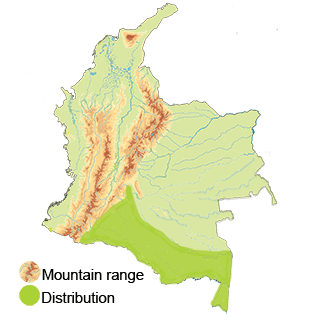Ocellated Poorwill
The Ocellated Poorwill (Nyctiphrynus ocellatus) Read in Spanish
Appearance: The Ocellated Poorwill is a small to medium-sized bird with a cryptic plumage that provides excellent camouflage in its forest habitat. It has a distinctive feature of ocelli (eye-like markings) on its wings, which give the bird its name. The bird typically has a mottled brown, black, and white coloration, contributing to its ability to blend in with its surroundings.
Habitat: The Ocellated Poorwill is primarily found in humid tropical forests and montane forests across its range, including regions of Colombia. It prefers dense undergrowth and forest edges where it can roost and forage for insects during the night.
Behavior: As a nocturnal species, the Ocellated Poorwill is most active during the night, using its keen hearing and vision to locate prey such as insects, spiders, and other small invertebrates. The bird is known for its secretive behavior, relying on its cryptic plumage and stealth to avoid detection by predators.
Breeding: Breeding behaviors of the Ocellated Poorwill may include courtship displays, vocalizations, and nest construction within its forest habitat. The female typically lays one or two eggs in a well-hidden nest on the ground, and both parents share incubation and chick-rearing duties.
Conservation Status: The Ocellated Poorwill is classified as "Least Concern" on the IUCN Red List.
Distribution
The Ocellated Poorwill (Nyctiphrynus ocellatus)
Amazon Region: Parts of the Colombian Amazon region, including areas within the Amazon rainforest and its associated ecosystems, are home to populations of the Ocellated Poorwill.Within the Amazon, the bird may inhabit lowland forests, riverine forests, and other habitats rich in biodiversity.
Orinoquía Region: While less common in the Orinoquía Region compared to other regions, the Ocellated Poorwill can still be found in specific pockets of suitable habitat in this region. The bird may occur in gallery forests, riparian habitats, and other wooded areas within the Orinoquía.
Taxonomy
The Ocellated Poorwill (Nyctiphrynus ocellatus)
- Kingdom: Animalia
- Phylum: Chordata
- Class: Aves (Birds)
- Order: Caprimulgiformes
- Family: Caprimulgidae
- Genus: Nyctiphrynus
- Species: Nyctiphrynus ocellatus
Vocalization
The Ocellated Poorwill (Nyctiphrynus ocellatus)
- Call Types: The Ocellated Poorwill is known to produce a variety of vocalizations, including calls, trills, and soft hoots. Their calls are typically low-pitched, rhythmic, and repetitive, often heard during the breeding season or as part of territorial displays.
- Nighttime Vocalizations: As a nocturnal species, the Ocellated Poorwill is most active during the night, and its vocalizations are commonly heard after dusk and before dawn. The bird's calls may serve the purpose of establishing territories, attracting mates, and signaling its presence to other individuals in the area.
- Territorial Calls: Male Ocellated Poorwills may produce territorial calls to defend their nesting sites and foraging areas from intruders. These calls can be loud and repetitive, serving as a warning to other birds in the vicinity to stay away.
- Courtship Calls: During the breeding season, male Ocellated Poorwills may engage in courtship displays that involve vocalizations to attract females. Courtship calls are often more elaborate and may include a series of vocalizations and wing displays.
- Communication: The birds may use different vocalizations to convey messages related to food availability, potential threats, and other relevant information.




